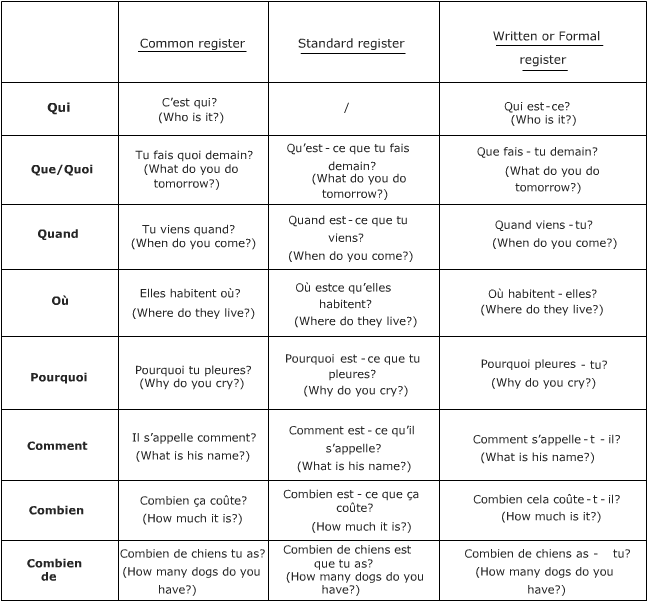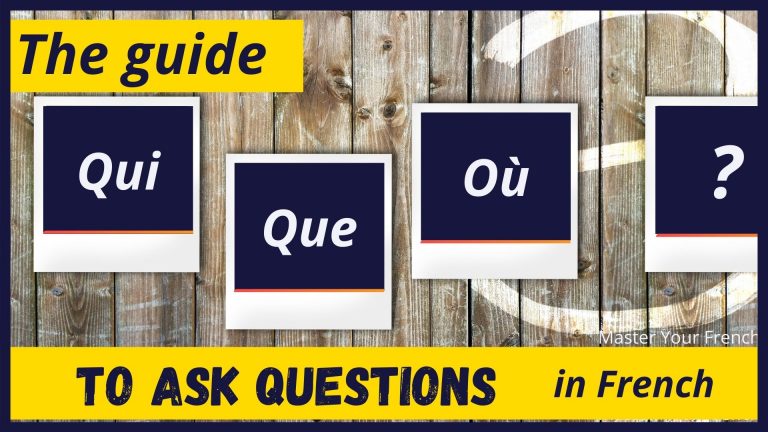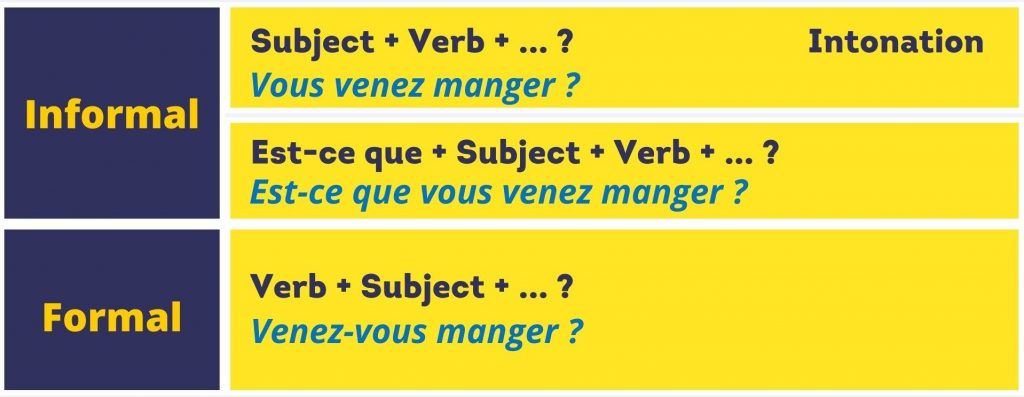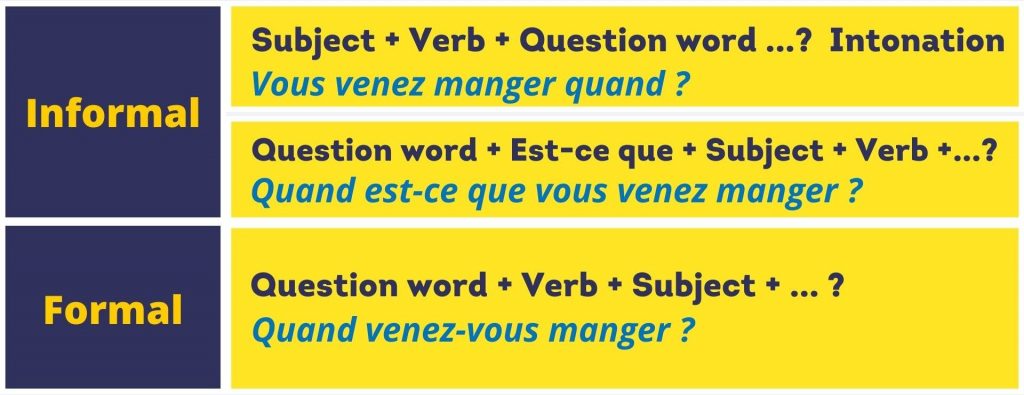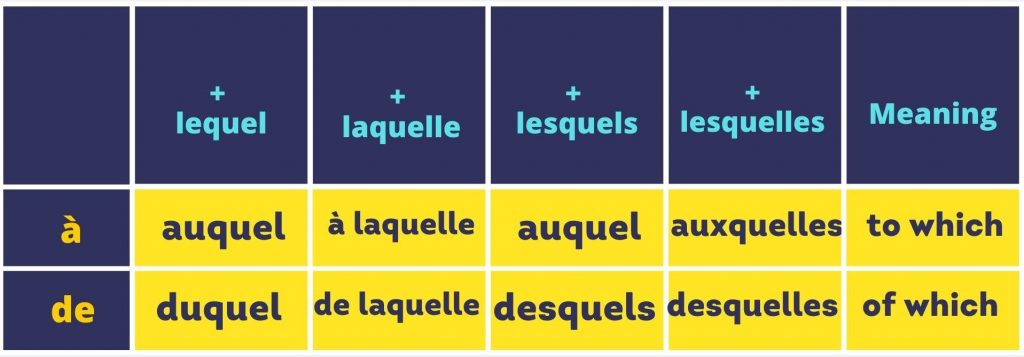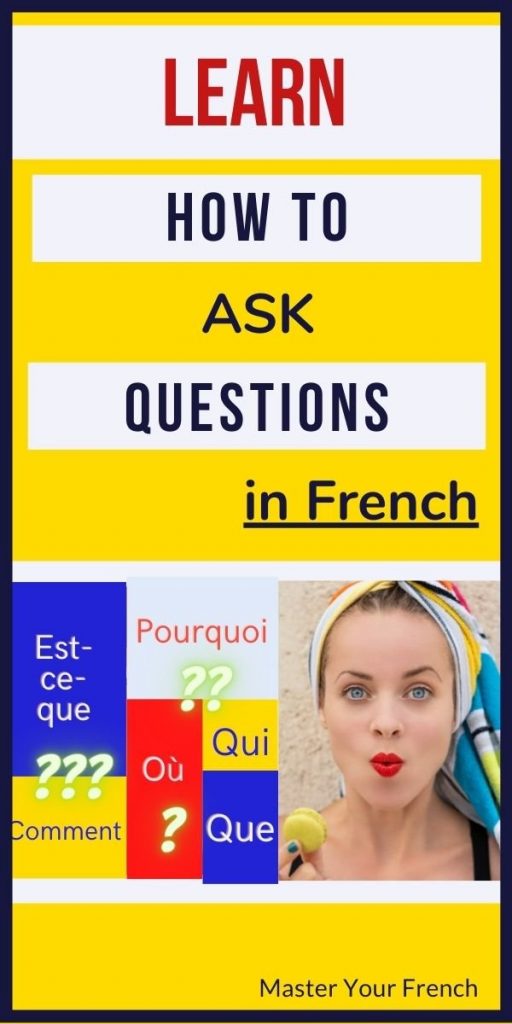Задаем вопросы на французском или порядок слов в вопросительном предложении
Сегодняшняя статья будет носить обзорный характер. В ней не будет правил составления вопросительных предложений. Я лишь поясню, каким образом строится вопрос во французском предложении и почему один и тот же вопрос можно задать по-разному.
О принципах построения вопросительных предложений в английском языке вы также можете почитать на моем блоге.
Эта тема назрела не случайно – на большинство тем меня вдохновляют мои ученики (за что им спасибо).
Дело в том, что когда ко мне приходят студенты начального уровня или уже освоившие некоторые азы языка, у многих возникает один и тот же вопрос – так как же правильно составить вопрос на французском языке?
Или – «а разве так правильно, ведь в Поповой-Казаковой вопросительные предложения строятся на инверсии, а сложная инверсия обязательна, если подлежащее выражено существительным или именем собственным?»
Какой порядок слов все-таки выбрать, чтобы звучать грамотно и в тему в любой речевой ситуации? Об этом пойдет речь ниже.
Порядок слов в вопросительном предложении – три варианта построения вопросов
Итак, во французском языке один и тот же вопрос почти всегда можно задать тремя способами:
- Используя прямой порядок слов. При этом мы даем понять, что это вопрос при помощи интонации. Tu viens aujourd’hui? – При придешь сегодня? В точности как в русском языке. Восходящая интонация и никакого волшебства!
- Используя оборот est-ce que и прямой порядок слов. Est-ce que tu viens aujourd’hui? Перевод тот же, просто добавляется непереводимая конструкция est-ce que.
- Используя простую или сложную инверсию. Viens-tu aujourd’hui?
Все три варианта переводятся одинаково. То есть если вы зададите вопрос любым из трех способов, это будет грамматически верно и вас точно поймут.
Но все-таки эти варианты имеются не случайно, потому разберем, в какой ситуации какой из них лучше использовать.
Также предлагаю другие полезные публикации на моем блоге:
- Как правильно назвать свой возраст по-французски — по ссылке.
- Как правильно произносится слово Plus и от чего зависит его произношение — в этом материале.
- Глаголы второй группы и список частотных глаголов вы найдете в этой статье.
Выбор типа вопроса в зависимости от ситуации

- просторечный – он же неформальный или разговорный;
- нейтральный – стандартный язык, который является литературной нормой, общеупотребительный;
- высокий – формальный, официальный, книжный.
Проще всего проследить на примере лексических единиц:
- Погнали – поехали – пустились в путь: неформальный – нейтральный – высокий регистр соответственно.
- Болтать – разговаривать – беседовать.
- Папа – отец – батюшка.
Каждое слово в ряду имеет какую-либо стилистическую окраску.
Выбор варианта вопроса во французском языке тоже попадает под языковой регистр, который в данном случае выражается не через лексику, а через порядок слов.
В таблице ниже рассмотрим, в какой ситуации какой вариант использовать:
| Языковой регистр | Примеры вопросов |
| Неформальный, разговорный стиль (Familier) | · Tu t’appelles comment?
· Tu vas où? · Ils rentrent quand? |
| Нейтральный
(Standard) |
· Où est-ce que tu vas?
· Comment est-ce que vous circulez en ville? · Quand est-ce qu’ils rentrent? |
| Формальный (Formel) | · Comment t’appelles-tu?
· Où allez-vous? · Quand rentrez-vous? |
Теперь все должно встать на свои места:
- В разговоре со сверстниками, друзьями, в неформальной обстановке используем первый вариант. Обратите внимание, что вопросительное слово, если таковое имеется, часто выносится в конец фразы. Чаще всего применяется в разговоре на «ты».
- В стандартной ситуации, в том числе в разговоре с незнакомым человеком в неформальной обстановке – в магазине, в поликлинике, на кассе, на улице, в разговоре с малознакомыми людьми – употребляем второй вариант. Он же самый распространенный. Подходит для общения как на «ты», так и на «вы».
- На официальных встречах, при проведении интервью и переговоров на высшем уровне применяем третий вариант. Он же наименее распространённый. Чаще всего употребляется при общении на «вы», гораздо реже, но допустимо – на «ты».
По большому счету, в большинстве случаев хватает два варианта – неформальный и нейтральный. Так как редко мы пребываем в настолько официальной обстановке, что нужно прибегать к использованию высокого регистра языка. Это касается и родного языка.
Если вам на начальных этапах сложно запомнить все три варианта построения вопросов, запомните в первую очередь второй вариант – тот, что с est-ce que. Такие вопросы являются самыми распространенными, французы используют их в речи постоянно. И в любой из вышеперечисленных ситуаций вы будете звучать адекватно – как в компании друзей, так и на собеседовании.
Надеюсь теперь, вам, любители французского языка, станет понятно, почему каждый вопрос можно задать в трех вариантах и в какой ситуации каждый из вариантов будет наиболее подходящим.
Do you ever get this feeling when speaking French? You have all the words you need to make the perfect sentence, but they just don’t fit together. This is what happens when you’re not comfortable with the word order and need to learn about the specifics of the correct French sentence structures.
It may seem confusing at first, but bear with me for a moment and I trust that you’ll find it to be quite simple. Except for a few tricky exceptions, the structures are always the same and are often very similar to English. With all the tips and tricks from this article and a bit of practice, it will come naturally in no time!
In this guide, we’ll explain everything you need to know about the French sentence structure, from basic sentences for beginners to impressive complex statements for sophisticated talkers.
Table of Contents
- Ordering Words in French
- Simple Sentences with Subject, Verb, and Object
- How to Build Complex Sentences
- Asking Questions
- Negative Sentences
- Practical Cases
- Le Mot De La Fin
1. Ordering Words in French
Rule #1: French is SVO
Like many other languages throughout the world, French is what we call an SVO language. This means that the default word order is: Subject – Verb – Object.
- {Je mange une pomme.} (“I eat an apple.”)
Rule #2: Don’t Skip the Subject
And unlike similarly rooted languages, such as Spanish or Italian, we don’t usually drop the subject of the sentence, even when it’s a pronoun.
- I speak French.
- (Yo) hablo Frances. (Spanish)
- (Io) parlo Francese. (Italian)
- Je parle Français.
Rule #3: Rules are Meant to be Broken
These are mainly the French word order rules of simple declarative sentences, but as soon as we enter imperative, interrogative, or negative sentences territory, it gets a bit wilder. I mean…it’s French we’re talking about.
And one more thing: Master Yoda is allowed to use OSV sentences and still sound cool, but it’s forbidden to the rest of us.
Le Français je parle. (“French I speak.”)
2. Simple Sentences with Subject, Verb, and Object
In the following sections, we’ll work with the most common type of sentences: declaratives.
A declarative sentence is used to make a statement. It declares or states something, and ends with a period. We can’t use declarative sentences to ask questions or give orders.
Let’s get back to our basic declarative sentence: Je parle Français. (“I speak French.”)
In this sentence, I’m stating that I speak French.
Like we mentioned before, there are mainly two things you need to know about declarative sentences and their basic word order in French:
- The word order is Subject + Verb + Object.
- We don’t drop the subject, even when it’s a pronoun.
To these basic rules, I would also add:
- Verbs are conjugated. Their ending depends on the subject.
- Ils parlent Français. (“They speak French.”)
- Nous parlons Français. (“We speak French.”)
- → You can learn more about conjugation in our Complete Guide on French Conjugation. It’s freely available on FrenchPod101.com.
- Objects must agree with the subject. Their ending also varies.
- Il est Américain. (“He is American.”)
- Elle est Américaine. (“She is American.”)
/! The main exception to the S+V+O rule is the imperative mood, where the structure becomes: V+O.
- Vous parlez Français. (“You speak French.”) → Parlez Français. (“Speak French.”)
- Nous mangeons des pommes. (“We eat apples.”) → Mangeons des pommes. (“Let’s eat apples.”)
Elle mange des pommes. (“She eats apples.”)
3. How to Build Complex Sentences
Now that we have the basics covered, it’s time to add more ingredients into the mix and spice it up with adverbs, adjectives, and pronouns to gradually make our sentence more exciting!
1 – Adding Adjectives:
Adjectives describe nouns to make them more interesting. Let’s see where to place them in a sentence.
According to French word order, adjectives usually go AFTER the noun they describe.
- Une pomme verte (“A green apple”)
However, some of the most common adjectives go BEFORE the noun.
- Une grosse pomme (“A big apple”)
Put in a sentence, it looks like this:
- Il mange une pomme verte. (“He’s eating a green apple.”)
- → Learn more about adjectives with our full guide and massive list of the Top 100 French Adjectives.
2 – Adding Adverbs:
Adverbs work together with and describe verbs, adjectives, or other adverbs to modify their meaning or make a sentence more precise.
When the adverb modifies a verb, it usually comes AFTER this verb. The word order is: S + V + Adv.
- Je parle lentement. (“I speak slowly.”)
Then, if we have an object, it would be: S + V + O + Adv.
- Je parle Français couramment. (“I speak French fluently.”)
When the adverb modifies an adverb or adjective, it usually comes AFTER the verb and BEFORE the adverb or adjective. The word order is: S + V + Adv + Adv.
- Je parle très lentement. (“I speak very slowly.”)
When we get to this level of complexity, things start becoming a bit more flexible.
For instance, both sentences are correct:
- Je parle Français couramment. (“I speak French fluently.”)
- Je parle couramment Français. (“I speak French fluently.”)
However, it comes with exceptions, such as the very common bien (“well”) which is placed BEFORE the object.
- Je parle bien Français. (“I speak French well.”)
- Je parle vraiment bien Français. (“I speak French very well.”)
Je parle Français bien.
- → Everything you need to know about adverbs you’ll find in our Complete Guide on French Adverbs, with a list of the most common adverbs you should know.
Not too confused with the colors, are you?
3 – Adding Pronouns
Brace yourself, this is where French language word order gets tough. Understanding the word order of pronouns in French isn’t always a walk in the park, and we’ll really just scratch the surface here.
Subject pronouns don’t move:
- Nicolas mange une pomme. (“Nicolas eats an apple.”)
- Il mange une pomme. (“He eats an apple.”)
Same thing for stressed pronouns:
- Il mange une pomme avec ses amis. (“He eats an apple with his friends.”)
- Il mange une pomme avec eux. (“He eats an apple with them.”)
However, direct and indirect pronouns are not as well-behaved.
- Nicolas donne une pomme. (“He gives an apple.”)
- Nicolas la donne. (“He gives it.”)
- Il donne une pomme à ses amis. (“He gives an apple to his friends.”)
- Il leur donne une pomme. (“He gives them an apple.”)
- Il la leur donne. (“He gives it to them.”)
- → For more information about pronouns, you can go through our Extensive Guide on French Pronouns, with lots of examples and grammar points.
And what happens when we put everything together?
- Je leur parle Français très lentement. (“I speak French with them very slowly.”)
- Il leur donne gentiment une pomme verte. (“He gently gives them a green apple.”)
4 – Adding Prepositions
Prepositions are words that usually precede a noun or pronoun and express a relationship to another element of the sentence. Prepositional phrases often answer questions such as:
- Where? Il mange une pomme dans la cuisine. (“He eats an apple in the kitchen.”)
- When? Il mange une pomme après le dîner. (“He eats an apple after dinner.”)
- How?
- Il mange une pomme avec eux. (“He eats an apple with them.”)
- Il mange une pomme sans se presser. (“He eats an apple without rushing.”)
- Il mange une pomme avec soin. (“He eats an apple with care.”)
Prepositions can be placed BEFORE or AFTER the verb. In some cases, you can freely choose, and in other situations, only one option will make sense.
- Après le dîner, je mange une pomme. (“After dinner, I eat an apple.”)
- Je mange une pomme après le dîner. (“I eat an apple after dinner.”)
- Il mange une pomme sans se presser. (“He eats an apple without rushing.”)
- Sans se presser, il mange une pomme. (“Without rushing, he eats an apple.”)
In these two examples, both versions are correct.
But sometimes, you need to know the verb for the preposition to be relevant:
- Je rentre à la maison. (“I go back home.”)
You would not say “Home, I go back,” and it would sound equally awkward in French.
- Je donne une pomme à mon ami. (“I give an apple to my friend.”)
Similarly, it wouldn’t make sense to mention the recipient before the action is stated.
To combine prepositions, you can simply apply the same logic when choosing where to place them:
- Après le dîner, je rentre à la maison sans me presser. (“After dinner, I go back home without rushing.”)
- Sans me presser, je mange une pomme avec eux dans la cuisine. (“Without rushing, I eat an apple with them in the kitchen.”)
These are not the words I ordered!
4. Asking Questions
The word order in French questions isn’t always SVO.
Questions can take several different forms in French, depending on whether you’re talking or writing, as well as how formal you want to be.
Let’s go back to our apple-eating example: Tu manges une pomme.
Here’s how to say: “Do you eat an apple?”
1. Tu manges une pomme ? (SVO)
2. Est-ce que tu manges une pomme ? (Est-ce que + SVO)
3. Manges–tu une pomme ? (VSO)
Now I guess the last one is confusing: Why do we suddenly invert the subject and verb?
This form is used only in writing or in very formal speech. Among friends, with random strangers, or in most business settings, you would stick to one of the first two options. I’d say both are equally common.
Now, what if we add some interrogative pronouns and adverbs?
Let’s see how to use words like: Quand (“When”), Qui (“Who”), Comment (“How”), Où (“Where?”).
“Where do you eat?”
1. Tu manges où ?
2. Où est-ce que tu manges ?
3. Où manges–tu ?
“When do you eat?”
1. Tu manges quand ?
2. Quand est-ce que tu manges ?
3. Quand manges–tu ?
5. Negative Sentences
Luckily, this is the last case, because I’m seriously running out of colors!
In this section, we’ll have a look at the word order in negative sentences.
Negative structures are placed around the verb and before the preposition or object.
- Je ne mange pas de pommes. (“I don’t eat an apple.”)
- Je ne mange pas dans la cuisine. (“I don’t eat in the kitchen.”)
- Je ne mange pas vite. (“I don’t eat fast.”)
The same thing goes for other negative structures:
- Je ne mange plus dans la cuisine. (“I don’t eat in the kitchen anymore.”)
- Je ne mange jamais dans la cuisine. (“I never eat in the kitchen.”)
That’s how I learned negative sentences!
6. Practical Cases
Now, it’s time to practice everything we’ve been learning today! We’ll take it slow and do it step-by-step. At any time, feel free to go back through the article if you’re having doubts.
Try to come up with the French translations for these sentences. You can use a conjugation table if you’re not sure how to deal with parler (“to speak”).
1. “We speak.” – _________________
2. “We speak French.” – _________________
3. “We speak French slowly.” – _________________
4. “We speak French slowly with her.” – _________________
5. “We speak with her in the kitchen.” – _________________
6. “After dinner, we speak with her in the kitchen.” – _________________
7. “We never speak with her in the kitchen.” – _________________
8. “Do you speak with her in the kitchen?” – _________________
“Where do I put these verbs again?”
“Where do I put these verbs again?”
[SPOILER] And here are the translations:
- “We speak.” – Nous parlons
- “We speak French.” – Nous parlons Français.
- “We speak French slowly.” – Nous parlons Français lentement.
- “We speak French slowly with her.” – Nous parlons Français lentement avec elle.
- “We speak with her in the kitchen.” – Nous parlons Français avec elle dans la cuisine.
- “After dinner, we speak with her in the kitchen.” – Après dîner, nous parlons avec dans la cuisine.
- “We never speak with her in the kitchen.” – Nous ne parlons jamais avec elle dans la cuisine.
- “Do you speak with her in the kitchen?” – Est-ce que tu parles avec elle dans la cuisine ?
7. Le Mot De La Fin
In this guide, you’ve learned a lot about French word order and the correct French sentence structures, from the basics to the most advanced parts such as French pronoun order.
Did we forget any important structure you would like to learn about? Do you feel ready to assemble ambitious sentences, using everything you’ve learned today?
As we’ve seen with the exercises, a good way to practice French word order is to start easy and slowly build up to complex sentences, one piece at a time.
Make sure to explore FrenchPod101.com, as we have plenty of free resources for you to practice your grammar and learn new words. Our vocabulary lists are also a great way to review the words and learn their pronunciation.
Remember that you can also use our Premium PLUS service, MyTeacher, to get personal one-on-one coaching. Practice talking about word order in French with your private teacher so they can give you personalized feedback and advice, and help you with the pronunciation.
About the Author: Born and bred in the rainy north of France, Cyril Danon has been bouncing off various jobs before he left everything behind to wander around the wonders of the World. Now, after quenching his wanderlust for the last few years, he’s eager to share his passion for languages.
Вопросительное предложение во французском языке можно построить разными способами:
- При помощи интонации: в этом случае порядок слов в предложении остается прямым, как в обычном повествовательном предложении, но фраза произносится с вопросительной интонацией. Подобный вид вопросительного предложения характерен для разговорной речи.
- При помощи вопросительного оборота est-ce que: порядок слов в предложении — прямой, оборот ставится в начало предложения; если есть вопросительное слово, то после него. Это стандартный, нейтральный способ постановки вопроса.
- При помощи инверсии: это обратный порядок слов в предложении, когда подлежащее становится после сказуемого. Применяется в возвышенной речи, в письменной речи. В устной речи желательно избегать этого вида вопросительного предложения.
NB! Прямой порядок слов: сначала идет подлежащее, за ним — сказуемое.
Инверсия = обратный порядок слов: сначала идет сказуемое, за ним — подлежащее.
Прямой порядок слов в вопросительном предложении
В вопросительном предложении прямой порядок слов встречается в следующих случаях:
- если вопрос выражается интонацией: Vous venez?
- если вопросительное предложение начинается с qui (кто) / qui est-ce qui (кто) / qu’est-ce qui (что) в функции подлежащего или quel (какой) в функции определения подлежащего: Qui a dit cela? Quel avion vient d’arriver?
- при обороте est-ce que (на русский язык обычно не переводится): Comment est-ce que vous lisez?
- в разговорной речи, если вопросительное слово ставится в конце предложения: Tu t’appelles comment?
- в разговорной речи, если в начале предложения стоит длинное вопросительное слово / оборот (comment, pourquoi, à quelle heure и т.п.): A quelle heure on arrive à Paris? Pourquoi tu ne viens pas avec moi?
Инверсия
Во всех остальных случаях вопросительное предложение характеризуется инверсией, т.е. обратным порядком слов. Инверсия бывает простой и сложной.
Простая инверсия
Простая инверсия делается, когда подлежащее выражено личным местоимением (это местоимения, которые обычно мы употребляем, когда спрягаем глагол, — tu, nous, ils и т.д.). В этом случае местоимение ставится после глагола, между глаголом и местоимением ставится дефис.
Перестановка местоимения je допускается лишь в некоторых односложных формах глаголов: ai-je? suis-je? dis-je? dois-je? vais-je? puis-je? С другими глаголами инверсия в форме «я» не делается — выбирается другой тип вопроса, обычно с оборотом Est-ce que.
Между глаголом (если он не оканчивается на t или d) и местоимением 3 лица единственного числа (il, elle, on) для благозвучия ставится буква t: Lit-il le journal? Pense-t-il à notre projet?
В отрицательно-вопросительном предложении частицы ne и pas окружают группу «глагол + местоимение-подлежащее»: N’est-il pas content?
В сложных временах инверсия делается между вспомогательным глаголом и местоимением-подлежащим: Ont-ils vu ce film? Ne les avez-vous pas rencontrés?
Сложная инверсия
Сложная инверсия делается, если подлежащее выражено существительным или местоимением (кроме личных — «я, ты, он …» или неопределенного on). В этом случае подлежащее остается на своем месте и кроме этого повторяется после сказуемого в виде личного безударного местоимения 3 лица соответствующего рода и числа (= «он, она, они»): Pierre est-il étudiant? Les nôtres sont-ils venus?
Примечание-наблюдение по поводу выбора между прямой и сложной инверсией в случае, когда подлежащее выражено существительным
Только сложная инверсия строится:
1) в общем вопросе (требующем ответа «да» / «нет»): Vos amis le savaient-ils?
2) в специальном вопросе, если в предложении имеется прямое дополнение: Où tes amis ont-ils vu ce film?
3) с pourquoi предпочтительнее сложная инверсия, и только она в сочетании со сложными временами: Pourquoi Paul est-il parti?
Напротив, нет сложной инверсии в предложениях с вопросительными словами:
1) qui: Qui est Marie Dupont par rapport à vous?
2) que: Que fait ton père?
3) quel est / quelle est / quels sont / quelles sont: Quelles sont tes nouvelles?
Общий вопрос (вопрос ко всему предложению)
Общий вопрос — это вопрос, который предполагает ответ «да» или «нет». Можно задать 4 способами. Возьмем утвердительное предложение «Tu vas au cinéma» (= «Ты идешь в кино») и поставим его в вопросительную форму разными способами:
1) При помощи изменения интонации на вопросительную. Порядок слов в предложении не меняется: Tu vas au cinéma? — Ты идешь в кино?
2) При помощи вопросительного оборота est-ce que с сохранением прямого порядка слов после него:
Est-ce que tu vas au cinéma? — Ты идешь в кино?
3) При помощи инверсии: Vas-tu au cinéma? — Ты идешь в кино?
4) При помощи оборота n’est-ce pas (= «не так ли»?), который ставится в конце фразы: Tu vas au cinéma, n’est-ce pas? — Ты идешь в кино, не так ли / да / нет?
Слова «ли» и «разве», употребляемые в общем вопросе в русском языке, на французский не переводятся:
Он идет в кино? = Идет ли он в кино? = Разве он идет в кино? = Est-ce qu’il va au cinéma?
Специальный вопрос
Предполагает употребление специальных вопросительных слов:
| где? | où…? | Où habites-tu? – Где ты живешь? |
| куда? | Où vas-tu? – Куда ты идешь? | |
| откуда? | d’où…? | D’où viens-tu? – Откуда ты идешь? |
| когда? | quand…? | Quand reviens-tu? – Когда ты вернешься? |
| во сколько? | à quelle heure…? | A quelle heure reviens-tu? – Во сколько ты вернешься? |
| как? | comment…? | Comment cet enfant lit-il? – Как читает этот ребенок? |
| почему? зачем? | pourquoi…? | Pourquoi est-ce que tu es en retard? – Почему ты опаздываешь? |
С вопросительными словами возможны три варианта построения фраз:
| 1 вариант | 2 вариант | 3 вариант |
| ? слово + инверсия
Quand reviens-tu? – Когда ты вернешься? |
? слово + est-ce que + прямой порядок слов
Quand est-ce que tu reviens? – Когда ты вернешься? |
прямой порядок слов + ? слово
Tu reviens quand? – Когда ты вернешься? ? слово + прямой порядок слов (обычно с длинными вопросительными словами) Pourquoi tu n’es pas venu? — Почему ты не пришел? |
Вопрос к подлежащему
| 1 вариант | 2 вариант | примеры | |
| к одушевленному подлежащему (кто?) | Qui + глагол в 3 л. ед.ч. | Qui est-ce qui + глагол в 3 л. ед.ч. | Qui habite rue Rivoli?
Qui est-ce qui habite rue Rivoli? Кто живет на улице Риволи? |
| к неодушевленному подлежащему (что?) | Qu’est-ce qui + прямой порядок слов | Qu’est-ce qui se passe? – Что происходит? |
Вопрос к прямому дополнению (дополнению без предлога)
| 1 вариант | 2 вариант | пример | |
| к одушевленному дополнению (кого?) | Qui + инверсия | Qui est-ce que + прямой порядок слов | Qui Serge rencontre-t-il?
Qui est-ce que Serge rencontre? — Кого встречает Серж? |
| к неодушевленному дополнению (что?) | Que + простая инверсия, даже если подлежащее выражено существительным
! Перед словом, начинающимся с гласной буквы или h que сокращается до qu’. |
Qu’est-ce que + прямой порядок слов | Que prépare Marie?
Qu’est-ce que Marie prépare? –Что готовит Мари? Qu’as-tu fait? — Что ты сделал? |
Вопрос к косвенному дополнению (дополнению с предлогом)
| 1 вариант | 2 вариант | примеры | |
| одуш.
дополнение |
Предлог + qui +
est-ce que + прямой порядок слов |
Предлог + qui
+ инверсия |
1.Avec qui est-ce
que tu pars? 2. Avec qui pars-tu? – С кем ты уезжаешь? |
| неодуш.
дополнение |
Предлог + quoi +
est-ce que + прямой порядок слов |
Предлог + quoi
+ инверсия |
1.De quoi est-ce
que vos amis parlent? 2. De quoi vos amis parlent-ils? – О чем говорят ваши друзья? |
Вопрос к определению
| к подлежащему | к дополнению | ||
| какой? | quel (м.р. ед.ч.)
quelle (ж.р.ед.ч.) quels (м.р. мн.ч.) quelles (ж.р. мн.ч.) + существительное или lequel (м.р. ед.ч.) laquelle (ж.р.ед.ч.) lesquels (м.р. мн.ч.) lesquelles (ж.р. мн.ч.), употребленные самостоятельно, без существительного. ! Перед вопросительным словом может при необходимости ставиться предлог. В этом случае не забудьте про слитные артикли для составных форм местоимений: auquel, duquel и т.д. |
+ прямой порядок слов
Quel parc est beau? – Какой парк красивый? Lequel de ces exercice est oral? — Какое из этих упражнений устное? |
1) + est-ce que + прямой порядок слов
Quel livre est-ce que tu lis? — Какую книгу ты читаешь? Lesquels est-ce que tu as lus? — Какие ты прочитал? De quel film est-ce que vous parlez? — О каком фильме вы говорите? 2) + инверсия Quel livre lis-tu? – Какую книгу ты читаешь? A quelles filles a-t-il souri? — Каким девочкам он улыбался? Il y avait trois candidats. Pour lequel as-tu voté? — Было три кандидата. За какого ты голосовал? |
| сколько? | combien de (d’) + существительное | + прямой порядок слов
Combien d’étudiants travaillent ici? – Сколько студентов здесь занимается? |
1) + est-ce que + прямой порядок слов
2) + инверсия Combien de livres est-ce que tu lis? Combien de livres lis-tu? – Сколько книг ты читаешь? |
Вопрос к именной части сказуемого
| к существительному | к прилагательному | |
| какой? / каков? | quel / quelle / quels / quelles + глагол être
Quelle est la différence entre un dessert et un désert? — Какова разница между …? Quel sera le but du club? — Какая будет цель у клуба? |
comment + глагол (чаще всего être)
Comment est ta maison? — Каков твой дом? |
Вопросительно-отрицательная форма, или вопрос в отрицании
Отрицательная форма в вопросительном предложении строится по основным правилам: две отрицательные частицы (чаще ne и pas) окружают глагол:
Il ne vient pas?
Est-ce qu’il ne vient pas?
Если отрицание должно построится в инверсии, то внутрь отрицательной конструкции попадает глагол и подлежащее-местоимение:
Ne vient-il pas?
Reading time: 6 minutes
Difficulty: Beginner
Questions are an essential part of any conversation, and being able to properly formulate a question in French is an extremely important part of your learning. Especially if you are naturally curious, asking questions in French is something you should want to learn more. In this article, we will look into the different ways that you can ask your questions using the French language.
There are five ways in which questions are phrased in French. These are the following:
- By turning a statement into a question
- By using est-ce que
- By changing the order of the words in the sentence
- By using n’est-ce pas or non; and
- By using question words
Get your free copy of The Most Common Questions in French
I. TURNING A STATEMENT INTO A QUESTION
The easiest way to ask a question in French is simply to take any statement and make it a question by changing the pitch of your voice. In writing, this can be done by adding a question mark at the end of the sentence. This type of asking questions is deemed informal but is still widely acceptable in regular, everyday type of conversations. This method of asking questions is also commonly used in English, and like in French, the expected reply is either a yes or a no. For example, “You are a dancer?” “She told you I’m not interested?” “You saw the movie?” All of which are regular statements-turned-questions. Some examples in French:
- Il est arrivé. — He arrived.
- Il est arrivé? — He arrived?
- C’est vrai. — That’s true.
- C’est vrai? — Is that true?
- Vous aimez la France. — You like France.
- Vous aimez la France? — Do you like France?
II. USING EST-CE QUE
Another simple way to ask a question in French is to add est-ce que in the beginning of a sentence. Est-ce que literally means “is it that” in English, and is inserted before a regular statement to turn it into a question. The rest of the sentence structure stays the same.
For example:
- Tu connais Ingrid. — You know Ingrid.
- Est-ce que tu connais Ingrid? — Do you know Ingrid?
- Est-ce qu’il est arrivé? — Has he arrived?
Extra tip in using est-ce que:
You can put any question words right before it in a sentence to further create an even more specific question (not just a yes or no question).
Here is the structure:
Question word + est-ce que + regular statement.
More details and examples will be given on this when we discuss the question words later.
III. CHANGING THE ORDER OF THE WORDS TO FORM A QUESTION (INVERSION)
Inversion, or changing up the structure of a sentence, is the more formal way of asking questions in French. Normally, the subject is followed by the verb, but for the inverted questions, the verb is placed before the subject and then joined by a hyphen.
For example:
- Vous aimez la France. You like France.
- Kindly note that in this sentence, the subject precedes the verb.
- Aimez-vous la France? Do you like France?
The subject and verb switch places and are linked by the hyphen.
- Just like in using est-ce que, you can also add a question word before the inverted question to further specify your query.
- In cases where the tenses consist of two or more words, the part of the verb which comes from avoir or être is the one to be used in the inversion and placed before the pronoun.
Example:
As-tu vu mon sac? Have you seen my bag?
Est-elle restée longtemps? Did she stay long?
- For verbs that end with a vowel, when used beside the pronoun il or elle, t is inserted between the verb and pronoun, making it easier to say.
Example: Aime-t-il les chiens? (Does he like dogs?)
IV. USING N’EST-CE PAS PAS OR NON
In cases where you are very sure that the person you are talking to will agree with you, you can add ne c’est pas at the end of the sentence. It is just similar to the English usage of “isn’t it?” or “right?” at the end of a question.
Non works the same way. It literally means “no?” and is also added at the end of the sentence. Hein is also similar. It is used just like “eh?” in English, and is often used in informal conversations.
Some examples:
Vous aimez la France, n’est-ce pas? You like France, don’t you?
Il est arrivé, n’est-ce pas? He arrived, didn’t he?
Vous aimez la France, non? You like France, right?
Vous aimez la France, hein? You like France, eh?
V. USING QUESTION WORDS
The fifth and last method of asking questions is to use interrogative words. The question words may be placed in the beginning or at the end of the sentence. It can also appear right before est-ce que, or before the inverted subject and verb.
Examples: When did you arrive?
Quand est-ce que tu es arrivé?
Quand es-tu arrivé?
Quand t’es arrivé?
T’es arrivé quand?
Here is a list of the most commonly used question words in French.
A/ Combien
- combien + verb? how much?, how many?
- combien de + noun? how much?, how many?
Examples:
combien coûte cet ordinateur? How much does this computer cost?
C’est combien, ce pantalon? How much are these trousers?
Tu en veux combien? How many do you want?
Combien de personnes vas-tu inviter? How many people are you going to invite?
B/ Comment? ( How? )
Examples:
Comment allez-vous? or comment vas-tu? How are you?
Comment tu t’appelles? What is your name?
C/ Où? Where?
Some French learners often confuse ou (no accent) and où (with accent). The first one means ‘or’ while the second means ‘where’.
Example:
Où allez-vous? (where are you going?)
D/ Pourquoi? Why?
Example:
Pourquoi est-ce qu’il ne vient pas avec nous? Why isn’t he coming with us?
E/ Quand? When?
Example:
Quand est-ce que tu pars en vacances? When are you going on holiday?
F/ Qui? Que? and Quoi?
These are pronouns which could mean who, whom, what and whose depending on how you use them: to refer to a person or thing, the subject or object, or if it follows a preposition. This is by far the most complicated of all question words, and it would be advisable if you could learn pronouns as well to get a better grasp of this topic.
Here are the basic rules:
- Qui – can be used when talking about people, and is similar to “who” (subject) or “whom” (object) in English.
| Who? Whom? |
Referring to people | Meaning | Examples | Meaning |
| Subject | qui? qui est-ce qui? |
Who? | Qui vient? Qui est-ce qui vient? |
Who’s coming? |
| Object | qui? qui est-ce que? |
who? whom? |
Qui vois-tu? Qui est-ce que tu vois? |
Who/Whom can you see? |
| After preposition | qui? qui est-ce que? |
who? whom? |
De qui est-ce qu’il parle? Pour qui est ce livre? À qui avez-vous écrit? |
Who’s he talking about? Who’s this book for? Who did you write to?, To whom did you write? |
Table source: Collins Easy Learning French Grammar
2. À qui is used to mean “whose?” Example: À qui est ce sac? (Whose is this bag?)
3. Que and quoi are used when talking about things and could mean “what?” The difference is, you use quoi when it follows a preposition.
| What | Referring to things | Meaning | Examples | Meaning |
| Subject | qu’est-ce qui? | what | Qu’est-ce qui se passe? Qu’est-ce qui t’inquiète? |
What’s happening? What’s worrying you? |
| Object | qu’est-ce que? | what | Qu’est-ce que vous faites? Que faites-vous? |
What are you doing? |
| After preposition | quoi? | what | À quoi penses-tu? De quoi parlez-vous |
What are you thinking about? What are you talking about? |
Table source: Collins Easy Learning French Grammar
4.Quel, quels, quelle, or quelles?
Quel can mean who? Which? Or what? It can be used together with a noun, or as a noun substitute (pronoun). On the other hand, que and quoi can never be used together with a noun.
The forms of quel are the following:
quel (masculine singular)
quels (masculine plural)
quelle (feminine singular)
quelles (feminine plural)
Examples:
| Quel est ton chanteur préféré? | Who’s your favorite singer? |
| Quel vin recommandez-vous? | Which wine do you recommend? |
| Quelle est ta couleur préféré? | What’s your favorite color? |
| Quelle heure est-il? | What time is it? |
| Quels sont tes chanteurs préférées? | Who are your favorite singers? |
| Vous jouez de quels instruments? | What instruments do you play? |
| Quelles sont tes couleurs préférées? | What are your favorite colors? |
| Quelles chaussures te plaisent le plus? | Which shoes do you like best? |
Examples source: Collins Easy Learning French Grammar
G/ lequel? laquelle? lesquels? and lesquelles?
Lequel is used to mean “which one?”and here are its different forms:
lequel (masculine singular) which one?
lequels (masculine plural) which one?
laquelle (feminine singular) which ones?
lesquelles (feminine plural) which ones?
Example:
Laquelle de ces valises est à Fred? Which of these cases is Fred’s?
Now that you have this guide, you’ll know how to ask questions in French. If you need clarification on this topic, do not hesitate to contact us in the comment section.
P.S. You would be doing me a HUGE FAVOR by sharing it via Twitter or Facebook.
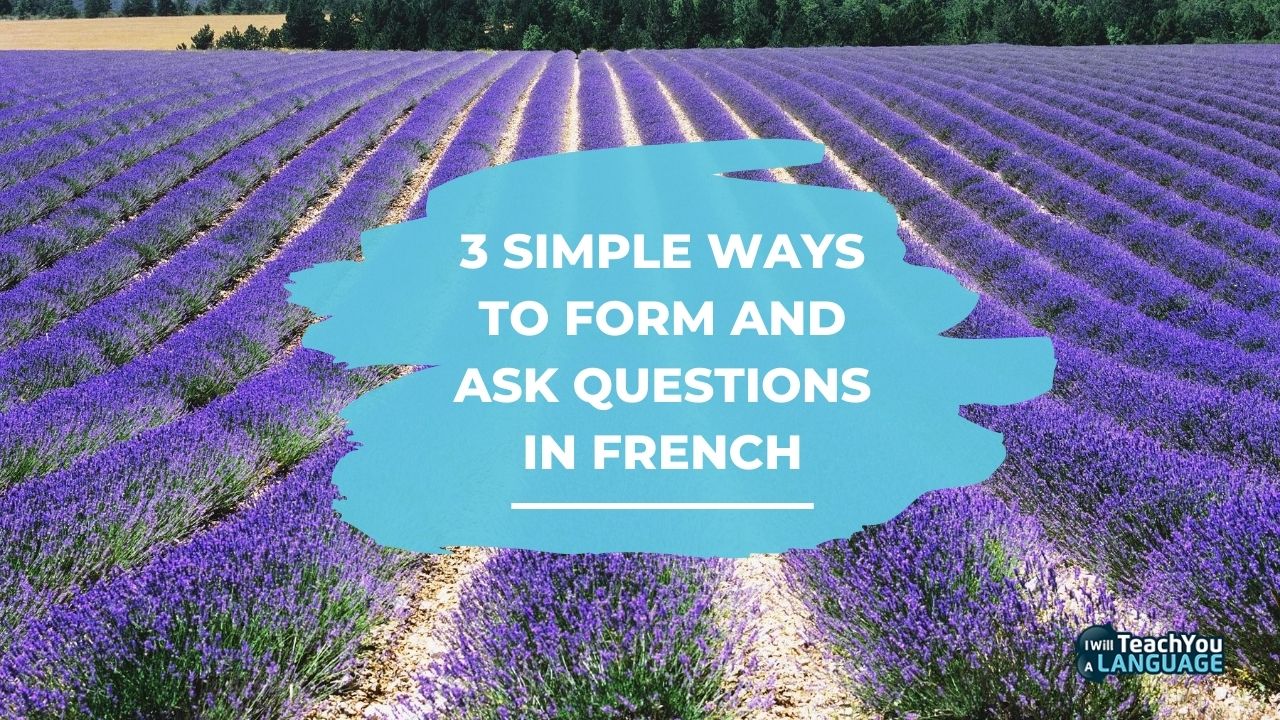
When you learn French, or any new language, one of the most basic functions is being able to ask questions. This allows you to obtain any information you require and engage in basic conversations with people.
French questions are not difficult, but there are few different ways to form them. So to help you master them, in this post I tell you everything you need to know about asking questions in French.
By the end of this post, you’ll be able to ask French questions with or without question words. That way, you’ll be able to chat more easily to your French-speaking friends and make your life much easier on your travels around French-speaking countries.
By the way, if you want to learn French fast and have fun while doing it, my top recommendation is French Uncovered which teaches you through StoryLearning®.
With French Uncovered you’ll use my unique StoryLearning® method to learn French naturally through story… not rules. It’s as fun as it is effective.
If you’re ready to get started, click here for a 7-day FREE trial.
French Questions – An Overview

In French, there are several different ways to ask questions, some of which are suitable for informal speech while others are considered more “proper” or “elegant””. However, once you get the hang of it, you will see how mastering a few basic patterns is all you need to be able to use the different forms with confidence.
In this post, I will start by looking at questions without “question words” (words like “when” and “why”) and then move onto the versions with question words. This way, you will be able to see how the same rules apply to both types.
As a general word of advice, with questions in French, always learn the constructions as chunks rather than breaking them down into individual words. Breaking them down won’t help, but if you just remember them as chunks, forming questions in French will be much easier.
So now let’s jump in and get started.
#1 The Easiest Way To Ask Questions In French – Intonation

To begin, let’s start with the very easiest way to ask questions in French.
The most basic way of asking a question in French is simply to use the intonation of your voice to change a statement into a question. For example:
- tu veux une bière (you want a beer)
- tu veux une bière ? (you want a beer?)
As you can see, apart from the question mark, there is no difference on the page. But when spoken, the intonation rises in the second version to indicate that you’re asking a question.
There will probably be some visual clues like the eyebrows being raised or the head being tilted back slightly, but that’s it – how to ask a question in French!
We do this in English too, but it’s much more common in French – which is why you will often hear French speakers using questions like this when they speak English.
#2 Questions With Est-ce Que

The second way of asking questions is where some beginners start to get nervous, but there’s no need because it’s still very simple.
The first form we looked at is an informal version used in casual spoken French. However, to raise the level of language slightly, you just add est-ce que at the beginning of the question.
Some beginners get confused here because they don’t understand what est-ce que means, but you don’t need to worry.
Don’t think about the meaning because it doesn’t really mean anything. All you need to know is that you put this chunk at the start of a statement to turn it into a question – simple!
Here’s an example:
- Est-ce que tu veux une bière ? (do you want a beer?)
As you can see, it’s the same as the statement from the first example – but just with est-ce que tacked on at the beginning.
This is considered a more “proper” or “elegant” way to form a question, although it is common in informal French as well as in more formal settings – so you are just as likely to hear it in a bar as in a business meeting.
Notice that in my English translation, I used the “do” form. When you make a question in English, “do” doesn’t really have any meaning – and this is quite similar to how est-ce que works in French.
#3 Making Questions By Inverting The Word Order

In French, you can also make questions by inverting the word order and adding a hyphen, like this:
- veux-tu une bière ? (do you want a beer?)
- êtes-vous marié ? (are you married?)
- as-tu déjà mangé ? (have you already eaten?)
- a-t-elle déjà mangé ? (has she already eaten?)
In English, we can use this type of construction when the verb is “be” and with the present perfect tense (the “have done” form). However, in French, it can be used with other verbs too, as in the first example with vouloir (to want).
Note that when the verb ends in -a or -e, you need to insert a “t” with hyphens either side, as in the last example. However, this doesn’t change the meaning in any way and is just to make it easier to say.
Finally, also note that this construction isn’t usually used with the je (I) form – except with devoir (must), pouvoir (to be able), être (to be) and sometimes avoir (to have). For example:
- dois-je venir ? (must I come?)
- puis-je venir ?* (can/may I come?)
As with the est-ce que form, these questions can be used in both formal and informal settings.
*Always use puis and never peux – this is just a special form of pouvoir that only appears in this kind of inverted question.
3 Ways To Form French Questions With Question Words

So far, we have looked at questions without question words. But now we need to look at how to make questions with them.
You’re in luck as there’s a lot of overlap with what you’ve just seen in the previous section. In fact, you’ll see that you can form French questions with question words using the same three methods.
Just like with non-question word questions, there is an easy way to do it, so let’s look at that first.
With many question words, you can simply put the question word at the start of the statement to turn it into a question, like this:
- où tu vas ? (where are you going?)
- pourquoi t’y vas ? (why are you going (there)?)
- quand vous partez ? (when are you leaving?)
These forms are not considered particularly elegant – and you certainly wouldn’t want to use them in writing – but in everyday speech, they are extremely common.
Sometimes, you can also put the question word at the end, like this:
- tu vas où ? (where are you going?)
- vous partez quand ? (when are you leaving?)
- il a fait quoi ? (what did he do?)
- c’est quoi ? (what is it?)
Again, this is not considered super-correct French, but it’s extremely widespread in informal situations – and these forms are easy for beginners to remember.
A point to note here is that you can use this construction with quoi (what) at the end of the sentence but not at the start of the sentence.
Question Words With Est-ce que

You can also use question words with est-ce que, and it works in much the same way as questions without question words.
Have a look at these examples:
- où est-ce que tu vas ? (where are you going?)
- quand est-ce que vous partez ? (when are you leaving?)
- qu’est-ce que nous allons commander ? (what shall we order?*)
- qu’est-ce qu’on commande ? (what are we going to order?*)
- qu’est-ce que c’est ? (what is it?)
- qu’est-ce qu’il a fait ? (what did he do?)
With these forms, all you do is add est-ce que between the question word and the rest of the sentence. You don’t need to know what est-ce que “means” because it doesn’t really “mean” anything – you just need to know that you use this chunk after the question word to make a question. There’s no need to make things any more complicated than that!
Note that here we make a “what” question by using que as the question word (shortened to qu’). Compare qu’est-ce qu’il a fait ? with il a fait quoi ? from the section above.
*These are basically the same question – but the version with nous is a more formal way to say it while the version with on is more colloquial.
Using Question Words & Inverted Word Order

Similar to the forms without question words, you can also make questions with question words by inverting the word order.
Here are some examples:
- comment as-tu oublié ? (how did you forget?)
- pourquoi est-il venu ? (why did he come?)
The only difference here is that you add the question word at the start of the sentence.
In informal spoken French, you can also choose a different word order, like this:
- pourquoi il est venu ? (why did he come?)
- il est venu pourquoi ? (why did he come?)
You might not find these versions in your grammar book – but you will certainly hear them if you talk to native French speakers!
French Questions With Qui – “Who” Questions

“Who” questions are different from other questions since the construction depends on whether the question is about the subject of the sentence (the person “doing” the action) or the object of the sentence (the person “receiving” the action).
If it is about the subject, you can use qui est-ce qui, like this:
- qui est-ce qui t’a dit ? (who told you?)
Here, the question is about the subject of the sentence because we are asking about the person who “did” the telling – so we use qui est-ce qui.
A simpler way to ask this question also exists, like this:
- qui t’a dit ? (who told you?)
The meaning of these sentences is the same – they are just two alternative ways of framing the same question.
On the other hand, if the question is about the object of the sentence, you use qui est-ce que instead, like this:
- qui est-ce que vous avez invité ? (who did you invite?)
In this sentence, the question is about the person who “received” the inviting, so we use qui est-ce que.
However, in more informal spoken French, simpler versions are possible, like this:
- qui avez-vous invité ? (who did you invite?)
- vous avez invité qui ? (who did you invite?)
As with similar constructions we’ve already seen, these are perhaps not the most elegant ways to ask the question, but they are perfectly normal and can be good shortcuts for beginners.
Again, the trick with these forms is to try not to deconstruct the sentence. Instead, just remember the words as a chunk and don’t delve any deeper. You don’t need to know why it’s said like this, you just need to know how to say it.
Master The Patterns & Listen To Native Speakers
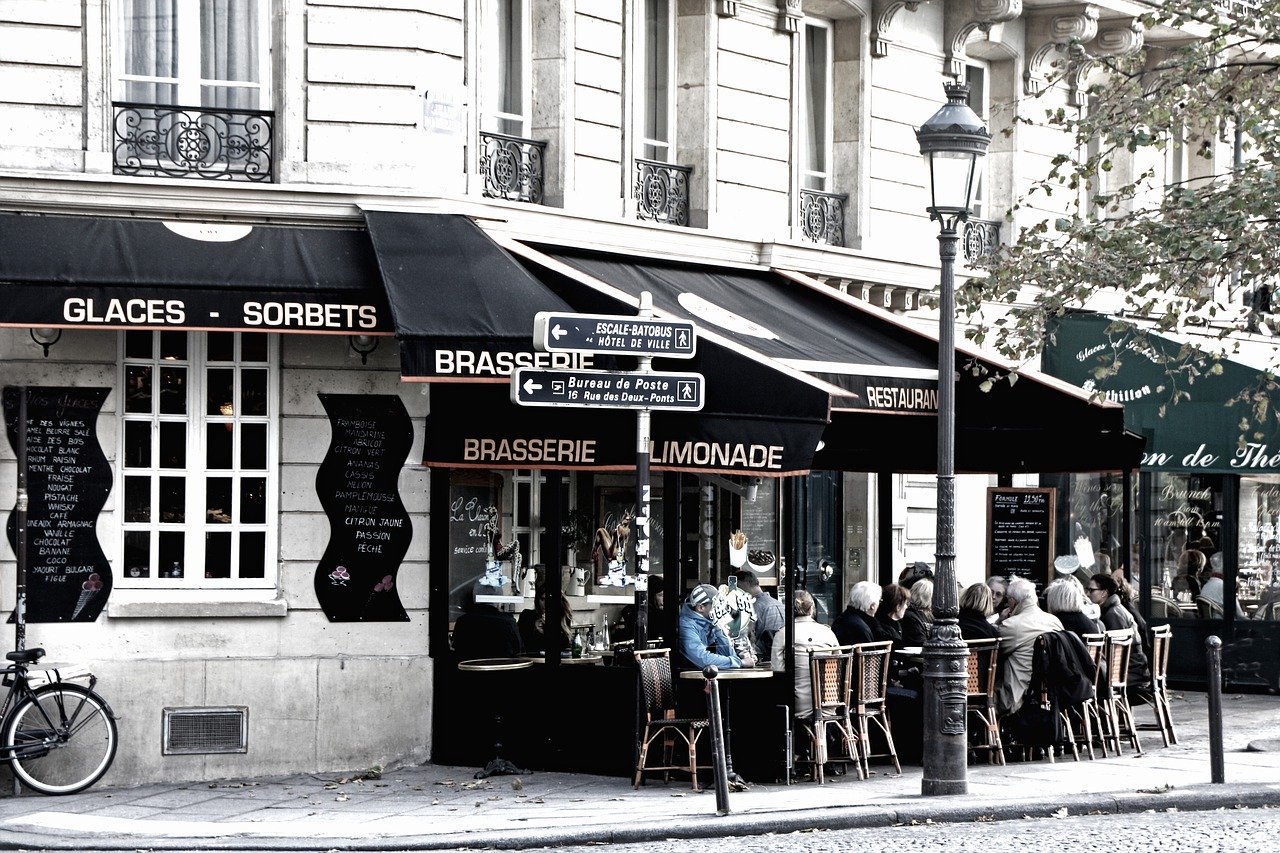
In this post, I’ve given you the more “elegant” longer forms using est-ce que and using inversions as well as the shorter informal versions that you are often likely to hear.
While the informal versions are best used only in casual settings, the other forms are in constant use, in both formal and informal situations. Furthermore, French speakers choose one form over another in different sentences because they just sound more natural, and this is something you will pick up with time.
At the beginning, your first job is mastering the patterns to be able to produce all of these forms automatically – and then by practising with native speakers, you will also start to understand which ones to choose naturally and without thinking.
Learn how to understand / answer questions in French fast with my free French lesson. Clear explanations + lists of common & more complex French question words.
Understanding questions in French fast is the key to a successful conversation.
In this free French lesson, I’ll explain the 4 ways of asking questions in French and give you lists of common French question words (aka interrogative expressions…)
1 – How To Ask Questions in French?
We have basically 4 ways of asking questions in French:
- To ask a question in a relaxed, everyday conversation, we just raise our voice.
Vous parlez français ? - To insist on the fact that you’re asking a question, you may use “est-ce que”.
Est-ce que vous parlez français ? - When we write, or in formal situations, we tend to use “inversion”, a French concept where you invert the subject and the verb.
Parlez-vous français ? - When you’re pretty sure the answer is yes, you may use the tag expressions “n’est-ce pas ?” or “non ?”
Now let’s study the different ways of asking questions in French in details.
Questions in French: the Modern “Everyday” Way
This is the most common construction, mostly used in spoken French, and it’s also the simplest – hence it’s popularity.
You just raise your intonation towards the end of the sentence!
Vous parlez français ? = Do you speak French?
If you use an interrogative expression (like when, why, where…) It goes all the way at the end of your sentence.
- Tu vas en France quand ?
When are you going to France? - Tu voyages avec qui ?
With whom do you travel?
Questions in French: “Est-ce que”
“Est-ce que” is nowadays mostly used to ask questions that can be answered by “oui” or “non”, and with “qu’est-ce que” (what do you…).
“Est-ce que” is pronounced [S keu] and it takes elision, so when followed by a vowel or an h, it becomes “est-ce qu’il(s)” [S kil], “est-ce qu’elle(s)” [S kel] etc…
“Est-ce que” means nothing by itself (watch out! It doesn’t always translate as ‘is’), it’s like the inverted question mark Spanish uses before the question: it warns you that a question is coming 
- Est-ce que tu vas souvent à Londres ?
Do you often go to London? - Est-ce que tu peux venir chez moi ?
Can you come to my house? - Est-ce qu’elle est française ?
Is she French? - Qu’est-ce que tu fais ?
What are you doing?
Questions in French: Inversion
Inversion is the most formal way of asking a question in French yet it’s still very much used, especially when using an interrogative expression.
In inversion, you pretty much invert the subject verb order, placing the verb first.
Pourquoi vas-tu à Paris ? = Why are you going to Paris?
Avec qui voyagez-vous ? = With whom are you traveling?
If you are studying French to pass exams, it is essential you know how to form your questions using inversion.
However, if you are learning French to communicate, you should be able to understand a question asked using inversion, but I wouldn’t worry about using it right away.
The modern everyday way to ask questions is much easier, if you ask me!
There is more to say about asking question with inversion since the construct can be quite complex.
Inversion, the various French question words etc.. are explained in depth and then illustrated by a level-adapted ongoing novel with audio – in my intermediate level French audiobook method – À Moi Paris L3.

À Moi Paris Audiobook Method
A new approach to learning both traditional and modern French logically structured for English speakers.
More Details & Audio Samples
Questions in French: N’est-ce pas?
Grammar makes it a question, so I have to list it here. But it’s only used as a tag question, when you are almost sure the answer is “yes”.
Tu es français, n’est-ce pas ? = You are French, right /aren’t you?
Instead of using “n’est-ce pas ?”, you could also just ask no in French: non ?
Vous aimez la France, non ? = You like France, don’t you?
And now let’s see what question words are used to ask specific informations.
2 – French Question Words
Interrogative expressions – or interrogative adverbs, and sometimes interrogative adjectives – are French question words used to ask for a particular piece of information.
They combine with prepositions to form more complex French questions and this is usually the part that holds students of French back when asking a question.
You can gain a lot of speed (and therefore confidence) by knowing these French question words by heart!
Most Common French Interrogative Expressions
You probably already know these French question words:
- Comment = how
- Où = where
- Quand = when
- Pourquoi = why – Note: to answer, use: parce que (parce qu’il-s, parce qu’elle-s)
- Combien = how many (de + noun)
- Qui = who, whom
- À quelle heure = at what time
Interrogative Expressions Combined with Prepositions
Basic French question words combine with prepositions (from, of, about, to, until, for…) to create more complex interrogative expressions.
Some usually confuse students, so make sure you understand these constructs.
I am going to list the most common ones below, but there are more.
- Jusqu’où = up to where, how far
- D’où = from where
- Jusqu’à quand = until when
- Depuis quand = since when
- Pour quand = for when
- Jusqu’à quelle heure = until what time
- Depuis quelle heure = since what time
- Pour quelle heure = for what time
- Pour combien de = for how much/many
- Avec combien de = with how much/many
- Combien de temps = how long
- Pendant combien de temps = for how long
- Depuis combien de temps = since how long
- Que or qu’ = what + verb… as in what are you doing ? Que fais-tu, qu’est-ce que tu fais ?
- quoi = what (used mostly in Street French: tu fais quoi ? = What are you doing?)
- À quoi = usually used with a verb that is followed by à = penser à = À quoi tu penses ?
- De quoi = usually used with a verb that is followed by de = parler de = De quoi tu parles ?
- Avec quoi = with what
- Avec qui = with whom
- De qui =of, from, about whom
- À qui = to whom
- Pour qui = for whom
- Chez qui = at whose place
- Quel = which/what + masculine singular noun
- quels = which/what + masculine plural noun
- quelle = = which/what + feminine singular noun
- quelles = which/what + feminine plural noun
all pronounced “kel” - Pour quel = for which
- Avec quel = with which
- Chez quell (ami) = At which (friend’s) place
- De quel = of which / about which
- À quel = at which / in which
- Dans quel = in which / inside which
3 – Watch Out for Prepositions!
In spoken English, it is common to put a preposition at the end of the sentence. Example: Who does she work for?
It is not so in French: you HAVE TO group the preposition with the interrogative expression, in other
words, the preposition becomes part of your interrogative expression.
- Elle travaille pour qui ?
- Pour qui est-ce qu’elle travaille ?
- Pour qui travaille-t-elle ?
You can never say in French: “qui elle travaille pour ?”.
Sometimes, English omits the preposition in a question.
How long is she going to play the piano (for)?
In French, you always have to say the preposition.
Pendant combien de temps…(for how long)
Elle va jouer du piano pendant combien de temps ?
4 – The Secrets to a Successful French Conversation
Asking questions fast, and being able to understand them fast as well, is an essential part of French conversation. Most students can’t answer questions fast enough because they are surprised by the word order used in French to ask a question.
You expected: “comment vous appelez-vous ? ” – which is featured in so many learning method to ask “what’s your name”, but is rather formal – and were asked “vous vous appelez comment ?” – same question, but asked in a much more casual way, or “c’est quoi votre nom ?” even more casual.
And that’s were you freeze in “surprise”. You expected one variation and got another one, which you often try to translate word by word. That’s the mistake: in most situations, you don’t need to translate the question. You need to understand it’s a question, and grab the essential parts to be able to, within the context of that particular conversation, guess the rest and answer fast.
So I dedicated a whole audiobook to this subject: secrets of French conversation. 1 hour of audio, plenty of exercises switching between the different ways of asking questions and everything you could possibly want to know about asking questions in French!
I hope this lesson helps. If you’d like to stay informed of new free lesson release, please subscribe to my newsletter.
Much like English, French often makes it clear that a question is being asked by beginning the sentences with a «question word» like Que («what»), or by using a word order that is not standard for direct statements.
These are the question words, or interrogatives:
Qui? = Who?
Que?/Quoi? = What?
Quand? = When?
Où? = Where?
Pourquoi? = Why?
Comment? = How?
Combien? = How many?/ How much?
Quel/ Quelle/ Quels/ Quelles? = Which?
These words are so important to memorize!! You really can’t have a conversation without them, can you?
Notice that Quel/ Quelle/ Quels/ Quelles (Which) agree in gender and number with the noun(s) they are asking about.
Examples:
Quelle fleur tu veux? (Which flower do you want?)
Quel chien tu préfères? (Which dog do you prefer?)
French does not use any auxiliary verb (such as «do») to form questions — the exact same word forms are used in sentences, just the word order is different when forming a question.
In French, it is possible to make a question without using a question word:
*As in English, by raising your tone at the end, without changing the words in anyway.
Il est professeur? (He’s a teacher?)
*Using «est-ce que…»
Est-ce qu’il est professeur? (He’s a teacher?)
*Using the subject-verb inversion.
Est-il professeur? (Is he a teacher?)
With the question words, there are three manners to make a question depending on the register you want to use:
Updated: May 29, 2021 by Mylene in Guides and Tips ▪
Asking questions properly is an essential part of any conversation in French. We use questions to connect with a family member, to invite a friend, to ask for directions or for help, to ask for the time, to schedule a meeting, or to learn more about a product or service.
There are a number of ways of forming questions in French. Some questions are formal, while other questions are informal.
In this article, you’ll learn the easiest ways to ask questions in French.
- Yes/no questions – informal language
- Yes/no questions – formal language
- Yes/no questions – negative question
- Open questions – informal language
- Open questions – formal language
- The main question words in French
How to ask yes/no questions in French
The yes/no questions are an informal way to ask questions in French. The answer is usually a yes or a no. French speakers use this way of asking a question in everyday conversations.
Yes/no questions – informal language
#1 Use a rising intonation to ask questions in French
Structure:
- subject + verb + complement + ?
Asking questions in French is easy. You just have to:
- take any statement
- making your voice go up at the end of the sentence
Example:
Le repas est prêt.
Le repas est prêt ?
#2 Form questions with “est-ce que”
To insist on the fact that you’re asking a question, you may use “est-ce que”.
This type of question can be answered by yes or no.
It’s the inversion of “c’est que” (this is that).
Structure:
- est-ce que + subject + verb + complement + ?
You just need to put est-ce que at the beginning of the sentence.
Example:
- est-ce que le repas est prêt? Is the meal ready?
Note:
The sentence cannot be negative.
Yes/no questions – formal language
This is the more formal way of asking questions.
#3 Ask questions in French by changing word order
In ordinary sentences, the verb comes after its subject.
In this type of question, the verb is put before the subject.
In theory, you can use “tu” when you ask a question with inversion, but it doesn’t make much sense. Indeed you don’t use “tu” with formal language.
Structure
The subject pronoun and verb are inverted and joined with a hyphen: –.
When the verb ends in a vowel, -t- is inserted before the pronoun to make the words easier to say.
Structure:
- verb + (-t-) + pronoun + complement + ?
Example:
- A-t-il fini ? Is he done?
Notes
- Nouns are not inverted. When a full noun is used as a subject, you must add a subject.
- example: Pierre a-t-il fini ? Pierre, is he done?
- In compound tenses only the auxiliary is inverted:
- example: Pierre avait-il fini ? Was Pierre done?
Yes/no question – Negative question
#4 Anticipate a no when asking a question in French
On the other hand, when you expect the answer to be no, you have two options:
- Formal: use inversion with a negative adverb
- example: ne viens-tu pas ? Don’t you come?
- Informal: make a negative statement and raise your pitch at the end
- example: tu ne viens pas ? You don’t come?
How to ask open questions in French
Open question – informal language
The open question is used to obtain new information. You have to use a question word like who, what, what, where, how, why, how much, etc. The answer, therefore, contains new information that is not in the question.
#5 Adjust your intonation and make an open-ended question
Structure:
- subject + verb + question word + complement + ?
You need to raise the tone of your voice at the end of a sentence.
Example:
- Vous partez où en vacances ? Where do you go on vacation?
#6 Use est-ce-que to make an open-ended question
Structure:
- question word + est-ce que + subject + verb + complement + ?
Example:
- Où est-ce que vous partez en vacances ? Where do you go on vacation?
Open question – formal language
This type of question is used to get new information about a name. The answer is not in the question.
To form an open or partial question you just need to put the appropriate French question word at the end of the sentence.
#7 Add a question word to make an open-ended question
Structure:
- question word + verb + subject + complement + ?
Example:
- Où partez-vous en vacances ? Where do you go on vacation?
Note:
- Quoi + est-ce que becomes qu’est-ce que
How to use question words to ask questions in French
The main question words used in French
Question words are interrogative pronouns, adverbs or adjectives.
#8 Use interrogative pronouns to ask questions in French
When the subject is a person
Qui est-ce qui or qui + verb (who)
- Qui veut venir avec moi ? Who want to come with me?
- Qui est-ce qui veut venir avec moi ? Who want to come with me?
When the subject is a thing
Qu’est-ce qui
- Qu’est-ce qui te plaît ? What do you like?
When the direct object is a thing
Qu’est-ce que or que + inverted verb (what)
- Qu’est-ce que tu veux faire ? What do you want to do?
Que: what
- Que manges-tu ? What do you eat?
Lequel: which one, used for singular masculine nouns
- Lequel veux- tu manger ? Which one do you want to eat?
Laquelle is used for singular feminine nouns.
Lesquelles is used for plural feminine nouns.
Lesquels is used for plural masculine nouns.
- Duquel, de laquelle, desquels, desquelles
These pronouns may be combined with prepositions “à” and “de” to further specify the question being asked (see table below).
Example :
Duquel : c’est l’endroit duquel il est parti. That’s where he left.
A laquelle : il a chanté la chanson à laquelle je pensais. He sang the song I was thinking of.
#9 Choose an interrogative adverb to ask a question in French
Combien de + noun: how much
- Combien de temps avez-vous ? How much time do you have?
Où: where
- Où veux-tu aller? Where do you want to go ?
Comment: how
- Comment vas-tu ? How are you doing ?
Pourquoi: why
- Pourquoi pars-tu ? Why do you leave?
Quand: when
- Quand veux tu manger ? When do you want to eat ?
#10 Go for an interrogative adjective to start a question in French
Quel: which/what + masculine singular noun
- Quel dessert veux-tu manger ? Which dessert do you want to eat?
Quels: which/what + masculine plural noun
- Quels desserts veux-tu manger ? Which desserts do you want to eat?
Quelle: which/what + feminine singular noun
- Quelle tarte veux-tu manger ? Which pie do you want to eat?
Quelles: which/what + feminine plural noun
- Quelles tartes veux-tu manger ? Which pies do you want to eat?
Now you know how to ask questions in French.
You can find similar articles in our how-to french guides.
I encourage you to consider taking our online French courses and continue to explore the many benefits that Master Your French has to offer.
Happy learning journey, French learners!
Speaking French is more than just learning vocabulary words from flash cards. Words are just atoms, the building blocks of a language. They have to be put into context and strung together to form a sentence that is imparted with meaning.
Your French classes will teach you a lot about how to conjugate a verb, have your nouns and adjectives agree and what words and phrases will help you find the bathroom. What they might not teach you (but should) is sentence structure.
How are sentences put together in French? Does one use the dative, nominative, accusative and interrogative cases the same way as in English?
Setting aside that pesky grammatical gender agreement required to speak French properly, where and how do adjectives and adverbial phrases fit in a properly constructed sentence?
As an overview of these topics, Superprof presents this chart, one that you might consider printing and clipping and carrying with you to your French lessons or your French tutoring sessions.
| Type of Sentence | Form | Sample | Translation |
|---|---|---|---|
| Simple Declarative | S+V+O | La professeur aime ses éleves. | The teacher loves her students. |
| Negation | S+’ne’+V+’pas’+O | Je ne veux pas aller au cinéma. | I don’t want to go to the cinema. |
| Interrogative sentences | 1. Preface sentence with ‘est-ce-que’ 2. Reverse: V+S+O (formal) |
Est-ce-que tu as fait tes devoirs? Pourrez-vous me dire ou est la bibliothèque? |
Have you done your homework? Could you tell me where the library is? |
| Imperative sentence | V+O | Ouvre(z) la porte! | Open the door! |
| Simple declarative with adjective | S+V+Adj (adj must ‘agree’ with subject!) |
La fille est belle. Le chien est beau. |
The girl is pretty. The dog is pretty. |
| Adverbial pronoun | S+’y’+V | On y va! | Let’s go! |
| Relative clauses | ‘que’ for objects ‘qui’ for people |
Le livre que tu m’as donné… L’homme qui chante… |
The book you gave me… The man who is singing… |
Now, let’s examine each of these constructions in-depth…
But before you dive in, we’ve added a French playlist to enhance your reading experience while learning about French sentence structure. The playlist features a variety of French music, ranging from classic chansons to modern pop hits. Whether you’re a beginner or an advanced French learner, immersing yourself in the language through music can be a great way to improve your listening skills and vocabulary. So sit back, relax, and let the music transport you to the streets of Paris as you dive into the fascinating world of the French language.
The best French tutors available
5 (26 reviews)
1st lesson free!
5 (27 reviews)
1st lesson free!
5 (27 reviews)
1st lesson free!
5 (11 reviews)
1st lesson free!
4.9 (26 reviews)
1st lesson free!
4.9 (11 reviews)
1st lesson free!
5 (11 reviews)
1st lesson free!
5 (30 reviews)
1st lesson free!
5 (26 reviews)
1st lesson free!
5 (27 reviews)
1st lesson free!
5 (27 reviews)
1st lesson free!
5 (11 reviews)
1st lesson free!
4.9 (26 reviews)
1st lesson free!
4.9 (11 reviews)
1st lesson free!
5 (11 reviews)
1st lesson free!
5 (30 reviews)
1st lesson free!
Let’s go
French Sentence Structure: Understanding the Basics
French is a beautiful language, but it can be challenging to master its sentence structure, especially if you are a beginner. However, understanding the rules for forming proper sentences is essential for effective communication in French. In this article, we’ll explore the basics of French sentence structure and provide some useful tips to help you improve your French language skills.
Basic French Sentences and Word Order
In French, as in English, a sentence consists of a subject, verb, and object. The basic word order in French sentences is subject-verb-object (SVO). For example, «Je mange une pomme» means «I am eating an apple.» The subject «je» (I) comes first, followed by the verb «mange» (am eating), and then the object «une pomme» (an apple).
French Sentence Starters and Construction
To construct sentences in French, it’s essential to have a good grasp of sentence starters and construction. Some common sentence starters in French include «Je suis» (I am), «Il y a» (There is), «C’est» (It is), and «Il faut» (It’s necessary).
When constructing sentences, it’s important to pay attention to gender and number agreement. For example, if you want to say «I like the cat,» you would say «J’aime le chat» (not «J’aime la chat»). Similarly, if you want to say «I like the cats,» you would say «J’aime les chats» (not «J’aime le chats»).
French Time Phrases and Directional Words
Time phrases and directional words are also essential components of French sentence structure. Some common time phrases in French include «aujourd’hui» (today), «demain» (tomorrow), and «hier» (yesterday). Directional words such as «à droite» (to the right) and «à gauche» (to the left) are also important for giving directions.
Other Important French Sentence Structure Elements
French also has several conjunctions that are important for linking ideas and constructing more complex sentences. Some common French conjunctions include «et» (and), «mais» (but), and «ou» (or).
Si clauses are another important element of French sentence structure. These clauses are used to express hypothetical situations and typically begin with «si» (if). For example, «Si j’avais de l’argent, j’achèterais une voiture» means «If I had money, I would buy a car.»
With french sentence structure, remember to pay attention to gender and number agreement, use common sentence starters, and include directional words and time phrases to enhance your French language skills. In addition, understanding the grammar rules of French sentence structure is essential for effective communication in the language.
The Simple Declarative Sentence
The most common type of sentence in English and in French is the declarative sentence; a simple expression stating a fact:
Il fait beau.
It (the weather) is nice.
Catherine est une adolescente.
Catherine is a teenager.
Ma mère est danseuse.
My mother is a dancer.
Il écoute la musique.
He listens to music.
As in English, the declarative form in French is the core around which more complicated sentences can be built.
Basic French sentences with nouns
When you learn a language, you start with basic sentences with the most common word order.
In French, this is SVO — Subject + Verb + Object. As for most Romance languages — and, indeed, English — the subject (who is doing the action?) generally comes at the beginning of the sentence.
There follows the verb, and then the direct object (what is he/she doing?). The sentences above are all examples of the SVO construct.
We now expand on that basic sentence structure by adding an indirect object (for/to/with whom is he doing it?):
Subject + Verb + Direct Object + Indirect Object
Marie donne le livre à sa mère.
Marie gives the book to her mother
Jean rend le cartable à son frère.
Jean gives his brother his rucksack back.
Suzanne apporte les pommes à la cuisine.
Suzanne brings the apples to the kitchen.
Lucy rend les livres à la bibliothèque.
Lucy returns the books to the library.
Je prête mon vélo à mon ami.
I lend my bike to my friend.
Marie donne le livre à sa mère.
Marie gives the book to her mother.
Nous offrons des fleurs à notre mère.
We offer flowers to our mother.
Vous envoyez une lettre à votre grand-mère.
You send a letter to your grandmother.
In each of these examples, the subject is doing something with the direct object for, to or with the indirect object.
Until now, we’ve only shown simple sentences using action verbs: somebody or something doing something. What about sentences that use a compound verb?
In French as in English,
compound verbs consist of an auxiliary verb and a participle verb form,
either in the past or present tense.
In English, these ‘helper’ verbs are to be, to have and to do. In French, only the first two, être and avoir, are used in compound structures with being être used less frequently.
Nevertheless, the structure remains the same: the verb that indicates what is happening stays in second place:
Le roi avait pardonné le mousquetaire.
The king had pardoned the musketeer.
J’ai fini la vaisselle.
I have finished the dishes.
Les parents ont gaté ces enfants!
The parents have spoiled these children!
Le proffeseur avait donné des devoirs.
The teacher had given homework.
Mon copain est arrivé hier soir.
My mate arrived yesterday evening.
The only time a direct object might come after an indirect object is if there is additional information attached to it, such as a relative clause:
Jean rend à son frère le cartable qu’il lui avait prêté.
Jean gives his brother back the rucksack he had lent him.
Ma soeur montre à ma mére les dessins que j’avais peint.
My sister shows my mother the drawings I painted.
Mon collegue dit à nôtre patron que je suis fainéante!
My colleague tells our boss that I am lazy!
Benoit lit à sa copine des pôemes qu’il trouve romantique.
Benoit reads to his girlfriend poems he finds romantic.
Gabriel donne à sa soeur les bonbons qu’il avait promi.
Gabriel gave to his sister the sweets he had promised.
Naturally, you could structure the sentence in such a way that the direct object comes before the indirect:
Gabriel a donné les bonbons qu’il avait promi a sa soeur.
Gabriel gave the sweets he had promised to his sister.
However, that makes the sentence meaning ambiguous: He promised the candies to his sister, but who exactly did he give them to?
French being an exceedingly precise language, it is always best to follow the proper sentence structure in order to convey your intended meaning.
It might take a bit of practice, but your language skills will be all the richer for it!
Word order with pronouns
As in many other languages, French words are put into a different order if some or all of them are pronouns.
Let’s take the sentence:
Marie montre son dessin à sa maman.
Marie shows her drawing to her mum.
Subject pronouns stay at the beginning of the sentence:
Elle montre son dessin à sa maman.
She shows her drawing to her mum.
Sometimes, in French, it is much more convenient to describe an object in a sentence by using a pronoun.
Consider the sentence above: She shows her drawing to her mum. How can that sentence be made less cumbersome?
| Elle lui montre son dessin. | ‘lui’ takes the place of ‘maman’ even though, generally, ‘lui’ represents a male. |
| Elle le montre à sa maman. | ‘le’ takes the place of the picture. In this sentence, the gender matches; dessin is masculine. |
| Elle le lui montre. | here, you have a combination of the two representations above, with ‘le’ meaning ‘dessin’ and ‘lui’ in for ‘maman’. |
Let us now suppose you are that dear mum, telling a jealous mother about how your daughter creates artwork for you. You would say:
Son dessin? Elle me le montre!
Her drawing? She shows it to me!
Because of its first-person singular designation, “me” ranks higher than “le” — a mere article. Therefore, you would place ‘me’ before ‘le’ in such sentences.
Object pronouns come BEFORE the verb but AFTER the subject. In what order they come depends on the pronoun:
Subject + ‘me’, ‘te’, ‘se’, ‘nous’, ‘vous’ + ‘le’, ‘la’, ‘les’ + ‘lui’, ‘leur’ + (adverbial pronoun “y”) + ‘en’ + Verb.
Examples:
Elle nous les montre. She shows them to us. Note that ‘montre’ agrees with ‘elle’ — third person singular.
You might also phrase it as a question:
Elle vous les montre? Does she show them to you? Either way, the order listed above remains.
‘En’ is an indefinite plural pronoun that, in this sentence’s case, represents the drawings. ‘en’ is always placed just before the verb:
Elle montre des dessins à sa maman. -> Elle lui en montre. She shows some drawings to her mum. > She shows her them.
Learn more about French grammar rules.
Negative Sentences
The French negative words are: ne…pas and ne…point (the latter is archaic or regional).
“Ne” comes immediately after the subject.
“Pas” comes immediately after the verb.
Marie ne montre pas son dessin à sa maman.
Marie does not show her drawing to her mum.
Marie ne le montre pas à sa maman.
Marie doesn’t show it to her mum.
Marie ne lui montre pas son dessin.
Marie doesn’t show her her drawing.
Marie ne le lui montre pas.
Marie doesn’t show her it.
Negation is pretty straightforward in French, however you should be aware of using ‘any’ properly.
The equivalent of the English “no” or “not…any” is “ne…aucun”:
Marie ne montre aucun dessin à sa mère. Marie doesn’t show any drawing to her mother.
Or: Marie shows no drawings to her mother.
The best French tutors available
5 (26 reviews)
1st lesson free!
5 (27 reviews)
1st lesson free!
5 (27 reviews)
1st lesson free!
5 (11 reviews)
1st lesson free!
4.9 (26 reviews)
1st lesson free!
4.9 (11 reviews)
1st lesson free!
5 (11 reviews)
1st lesson free!
5 (30 reviews)
1st lesson free!
5 (26 reviews)
1st lesson free!
5 (27 reviews)
1st lesson free!
5 (27 reviews)
1st lesson free!
5 (11 reviews)
1st lesson free!
4.9 (26 reviews)
1st lesson free!
4.9 (11 reviews)
1st lesson free!
5 (11 reviews)
1st lesson free!
5 (30 reviews)
1st lesson free!
Let’s go
Adding Adjectives, Adverbial Phrases
Adverbs and adverbial phrases
The adverbial phrase or complément circonstanciel can come at the beginning, the end or the middle of the sentence. They are emphasised if they are put at the beginning or the end; it is more colloquial to only put single-word adverbs in the middle.
Such phrases may denote a time:
Marie lui montrera son dessin demain.
Marie will show him/her her drawing tomorrow.
strong>Demain, Marie lui montrera son dessin.
Tomorrow, Marie will show him/her her drawing.
Marie lui montrera demain son dessin.
Marie will show him/her tomorrow her drawing.
Or a place:
Marie lui montrera son dessin à l’école.
Marie will show her drawing at school.
À l’école, Marie lui montrera son dessin.
At school, Marie will show her drawing.
However, if you are using a complément circonstanciel construction to denote a place where an activity has happened, you cannot put that location in the middle of the sentence:
Marie lui montrera à l’école son dessin.
Marie will show him/her at school her drawing.
You’ll note that, as we do not know who the ‘lui’ in question is, it might represent a male or a female — hence both pronouns.
Adverbial pronouns
The adverbial pronoun “y” (directional) comes after most other pronouns but before the plural pronoun “en”. It is generally used to denote a progressive action, or one that is about to take place. However, ‘y’ can only be used if the listener knows what the speaker is talking about:
Marie va à l’école.
Marie goes to school.
If the listener knows where Marie is headed, the speaker could say: Marie y va — Marie is going.
Another example:
Nous irons au bois.
We go to the forest.
Contrast that with the much simpler: Nous y allons. We’re going — the usage is contingent on it being known where we are going!
Caution! You should never say:
Marie y va à l’école or Nous y allons au bois — it suggests the listener both knows and doesn’t know the destination.
Find French lessons that may interest you here.
Adjectives and their placement in the sentence.
Unlike in English, Adjectives are generally placed right after the noun:
Whereas an English speaker would say: ‘the red balloon’, in French, the proper order is: ‘le ballon rouge’. Here are some more examples:
- The hungry lion = le lion affamé.
- The sleepy child = l’enfant somnolent(e).
- The playful cat = le chat (la chatte) ludique.
- A good book = un bon livre.
Do you know of the BAGS group? It denotes constructions wherein the adjective comes before the noun:
- Beauty: Un joli ballon. A pretty balloon. More: Une jolie femme (a pretty woman), une belle chanson (a pretty song)
- Age: Un vieux ballon. An old balloon. More: Un viel homme (an old man), une vieille bicyclette (an old bicycle)
- Goodness: Un méchant ballon. A mean balloon. More: un bon vin (a good wine), une bonne amie (a good friend).
- Size: Un grand ballon. A big balloon. More: Un petit ballon (a small balloon), une petite fille (a small girl).
Adjectives used with verbs expressing a state come after the verb:
Le ballon est vert.
The balloon is green.
Le ballon semble petit.
The balloon seems small.
Le ballon deviendra grand.
The balloon will become big.
Note that adjectives should always agree with the noun they are qualifying in gender and number.
Le chat deviendra grand.
The (male) cat will become big.
La fille semble petite.
The girl seems small.
La voiture est verte.
The car is green.
Dependent and relative clauses
Most dependent or relative clauses come right after the main clause, at the end of the sentence.
Relative clauses
Relative clauses are introduced by the relative pronoun “que” if the noun is an object and «qui» if the noun is human.
These clauses are usually placed at the end of the sentence and come right after the noun they are qualifying — meaning that these nouns are sometimes moved from their usual place in the sentence.
An exception is if the qualifying noun is the subject, then the relative clause is moved forward. If it is very long it can be put between commas.
J’aime la chanson que tu chantes.
I like the song you are singing.
La chanson que tu chantes est belle.
The song you are singing is pretty.
Marie donne à Daniel le livre qu’elle a acheté.
Marie gives Daniel the book she bought.
Marie, qui aime la danse, donne le livre à Daniel.
Marie — who likes dancing — gives the book to Daniel.
Conjunctive clauses
Conjunctive phrases are clauses that are the object of a verb. The verb in question generally deals with thoughts and emotions and the expression of them. They are either infinitive clauses or are introduced with the conjunction “que”.
J’ai décidé de prendre le train.
I decided to take the train.
Elle aide William à apprendre le français.
She helps William learn French.
Il pense que je t’aime.
He thinks I love you.
Tu dis que tu veux mon amitié.
You say you want my friendship.
Check for French lessons for beginners here on Superprof.
The French Interrogative Sentence
French has several ways to build an interrogative. Here are some tips to improve your French dialogue:
Est-ce-que
Putting “est-ce-que” at the beginning of a sentence is the easiest way to formulate a question in French. You can use the usual word order following it.
Est-ce-que vous pouvez m’aider?
Can you help me?
Est-ce-que vous savez où se trouvent les toilettes?
Do you know where the toilets are?
Est-ce-que l’éléphant est le plus grand mammifère terrestre?
Is the elephant the biggest land-bound mammal?
Est-ce-que ce siège est pris?
Is this seat taken?
It is considered inelegant to preface your questions in this manner. During your French lessons, your teacher might insist you use reversal instead.
Reversing subject and predicate
The more elegant phrasing is to reverse the subject and predicate, putting the verb at the beginning of the sentence and hyphenating the subject-verb group:
Pouvez-vous m’aider?
Can you help me?
Savez-vous où se trouve les toilettes?
Do you know where the toilets are?
If the subject of the sentence is not the person you are addressing, it stays at the beginning of the sentence, and an additional subject “il” is added:
L’éléphant est-il le plus grand mammifère terrestre?
Is the elephant the largest land mammal?
Ce siège est-il pris?
Is this seat taken?
Question words
For questions that cannot be answered by yes or no, French uses question words. They come at the beginning of the sentence, and are followed by the inverted subject-verb group (also more idiomatically, they can also come at the end of a basic sentence).
Check for French conversation classes London here on Superprof.
Here is a list of French words for asking questions:
- Qui: who. Qui es-tu? Who are you?
- Que: what. Que fais-tu? What are you doing?
- Quoi: in rare cases, replaces “que”: Quoi faire?
- Où: where. Où vas-tu? Where are you going?
- Comment: how. Comment vas-tu? How are you?
- Pourquoi: why. Pourquoi manges-tu ces frites? Why are you eating those chips?
- Combien: how much. Combien coûte cette baguette? How much does this baguette cost?
- Quel/quelle/quels/quelles: which. Should agree with the noun it is qualifying: Quels cinémas jouent-ils le nouveau Star Wars? (Which cinema is showing the new Star Wars?) “Quel” can be combined with adverbial prepositions: Dans quel château Edmond Dantès était-il emprisonné? (In what castle was Edmond Dantès imprisoned?) Après quelle date peut-on manger des huîtres? (After what date can you eat oysters?)
Indirect questions
Indirect questions are questions that are related rather than asked. They are introduced by the usual question words:
Ils se demandent quels cinémas montrent le nouveau Star Wars. They are asking themselves which cinemas are showing the new Star Wars film.
Elle demande comment il va. She asks how he’s doing.
My Superprof tutor taught me the correct word order during our French lessons online!
The French Conditional Sentence
The language of Voltaire uses the pair of French words “si… alors” to express a condition over two clauses, though in some French phrases, “alors” is left off. It is considered more colloquial.
Si tu veux apprendre la langue, alors il faut bien apprendre ton vocabulaire français.
If you want to learn the language, so you will have to learn your French vocabulary.
“Si tu ne m’aimes pas je t’aime, et si je t’aime prends gare à toi!”
If you don’t love me, I love you; and if I love you: take care! (from the opera “Carmen”, by Bizet)
Check for French lessons for kids here on Superprof.
Don’t forget to do the grammar exercises in your French grammar textbooks and from your online French course to help you learn all about French sentence structure, learn French expressions and how to conjugate French verbs.
Find French classes Edinburgh on Superprof.
Key Takeaways
- French sentences typically follow a subject-verb-object (SVO) structure, but there are different sentence structures that can be used to convey meaning.
- Basic French sentences often include phrases like «where are you in French?» (où es-tu en français?), «to in French» (pour en français), and «of in French» (de en français), which are fundamental in basic sentence construction.
- French time phrases, such as «in the morning» (le matin) and «at night» (la nuit), are commonly used in French sentences and can be placed at the beginning or end of a sentence to convey meaning.
- Memorizing basic French verbs and the order of pronouns in a sentence is important to understand French sentence structure.
- Starting a sentence with a verb is a common structure in French, and can be used to emphasize the action or event taking place.
- It’s essential to study the language structure and form, as well as to memorize basic French phrases and sentence starters, like «on y va» (let’s go) and «vieux lion rouge» (old red lion) which translate to more familiar meanings.
- Finally, it’s important to master basic French grammar and sentence form in order to build more complex structures and effectively communicate in French.
На чтение 4 мин Просмотров 1.1к.
Содержание
- Порядок слов во французском предложении
- Порядок слов во французском языке в повествовательном предложении
- Порядок слов в вопросительном предложении во французском
- Порядок слов в побудительном и отрицательном предложениях
Сегодня обсудим порядок слов во французском предложении. Чаще всего это прямой порядок, но бывает и обратный, в результате которого меняется суть сказанного.
Порядок слов во французском предложении
Порядок слов во французском предложении или ordre des mots — фиксированный. Чаще всего порядок слов во французском языке — прямой (подлежащее + сказуемое + дополнение).
Бывает и обратный порядок слов (инверсия). Изменение порядка слов меняет часто и смысл фразы (Anne aime Paule. — Анна любит Поля. Paule aime Anne. — Поль любит Анну.)
Порядок слов во французском языке в повествовательном предложении
Порядок слов во французском языке в повествовательном предложении имеет чаще всего такую схему:
- Подлежащее + сказуемое + дополнение;
- Подлежащее + глагол-связка + именная часть сказуемого: Il est professeur. — Он преподаватель. То есть в обоих случаях будет прямой порядок слов.
Дополнение чаще всего стоит после сказуемого: Je regarde le film. — Я смотрю фильм.
Дополнение, которое выражено личным безударным местоимением, будет стоять перед сказуемым: Je lui parle. — Я с ним говорю.
Чаще всего прямое дополнение стоит перед косвенным:
- J’ai dit cela à ma femme. — Я сказал это своей жене.
Обстоятельство чаще стоит после сказуемого. Обстоятельство места и времени может занимать разные позиции во фразе: Je suis allée hier à 8 heures. — Я пошла вчера в 8 часов.
Определение следует за словом, к которому оно относится. Это определение может быть выражено относительным прилагательным, отглагольным прилагательным, существительным (Anne aime les sports d’hiver. — Анна любит зимний спорт.)
Порядок слов в вопросительном предложении во французском
Порядок слов во французском предложении может быть прямой или обратный, т.е. встречается и инверсия.
Прямой порядок слов остаётся:
- Подлежащее + сказуемое: когда вопрос выражается с помощью интонации (Tu aimes les pommes? — Ты любишь яблоки?), когда вопрос задаётся с помощью вопросительного оборота est-ce que (Est-ce que tu es content? — Ты доволен?). « Est-ce que » переводится на русский как «разве».
Инверсия бывает простой и сложной:
- Простая инверсия используется, когда подлежащее выражено безударным местоимением: Aimes-tu ce film? — Ты любишь этот фильм?
- Сложная инверсия используется, когда подлежащее выражается с помощью существительного или самостоятельного местоимения: Votre femme est-elle jeune? — Ваша жена молода?
Случается, что вопрос строится с помощью вопросительного слова и тогда используется прямой, либо обратный порядок слов.
Прямой порядок используется, когда подлежащее выражено с помощью вопросительного местоимения « qui » или будет использоваться наречие « combien de »: Combien de pommes il y a sur cette table? — Сколько яблок на этом столе?
Используется инверсия, когда дополнение выражено с помощью вопросительного местоимения « qui/que », а также сопровождается словами « quel », « combien de »: Que fais-tu? — Что ты делаешь?
Используется также инверсия, когда вопрос строится с помощью вопросительных слов « pourquoi », « comment », « quand », « où »…: Pouquoi es-tu parti? — Почему ты уехал?
Отметим! В современном французском языке используется чаще прямой порядок слов и оборот « est-ce que », а также вопросительное слово часто стоит после глагола: Elle part pourquoi? — Почему она уезжает?
Порядок слов в побудительном и отрицательном предложениях
В побудительном предложении на первом месте будет стоять глагол, затем будет использоваться дополнение, обстоятельство: Fais ce devoir aujourd’hui. — Сделай это задание сегодня.
В отрицательном предложении местоимение-дополнение будет стоять перед глаголом: Ne me le racontez pas. — Не рассказывайте мне этого.
Источник: https://sloovo.com/ru/biblioteka.php?type=obuchenie&language=FR&category=spravochnik&url=poryadok-slov-vo-francuzskom-predlojenii











